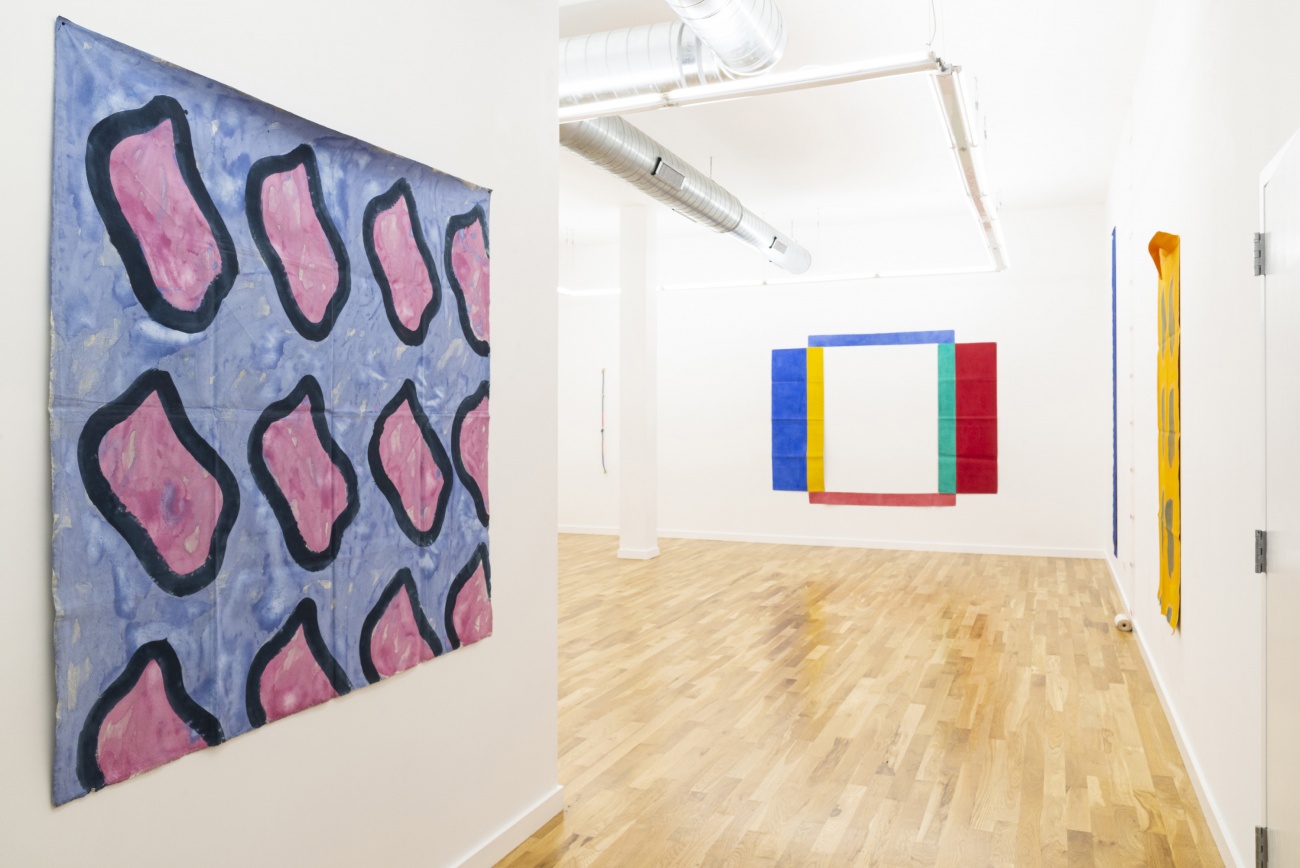





Opening Reception
Friday, September 13
5:00–8:00pm
DOCUMENT is pleased to present Supports/Surfaces: Objects of Knowledge, which features historical and recent work by Louis Cane, Noël Dolla and Claude Viallat. These three artists were members of Supports/Surfaces, a shifting group of some twelve French painters—André-Pierre Arnal, Vincent Bioulés, Cane, Marc Devade, Daniel Dezeuze, Dolla, Toni Grand, Bernard Pagés, Jean-Pierre Pincemin, Patrick Saytour, André Valensi and Viallat—who began collaborating and showing together in 1966. Supports/Surfaces: Objects of Knowledge will revisit Cane, Dolla and Viallat’s past work, while charting the evolution of their practices up through the present day.
The majority of Supports/Surfaces artists hailed from the South of France, from cities such as Montpellier, Nîmes and Nice, which lent the group an outsider status relative to Paris. Several of them showed together in Impact 1 at Musée de Céret in 1966, the first of a series of foundational exhibitions curated by Viallat and poet and critic Jacques Lepage. This show included key influences on Supports/Surfaces such as Arman and Ben Vautier, representatives of Nouveau Réalisme’s interest in found objects and the street, and Daniel Buren, who would devise a strict painting system with the BMPT group one year later. Viallat taught at Nice’s Ecole des Arts Décoratifs between 1964 and 1968, and pioneered Supports/Surfaces’ process-driven, anti-compositional strategies. In 1966, he arrived at a signature technique, repeating a softened rectangular form, via stencil, into gridded patterns that could extend over the entirety of a painterly surface, as exemplified in 1970/053, 1970, on view in this show. Here the artist’s use of black carbonyl leaks oil beyond the form delimited by the stencil, making it doubly “soft” as a contour. Viallat’s reinvention of the modernist “allover” technique obviates the frame and stretcher in favor of loose canvases that can be draped onto any site or hung from the ceiling in gallery space, resulting in radically mobile paintings. He also tied lengths of painted rope into configurations of knots, as in 1972/C23, 1972. The rope works are exercises in form: 1972/C23 alternates between different sections of blue and red in different hues, punctuated by knots. Yet as the artist has acknowledged, they also allude to maritime labor. In 1969, his Red Elastic Net with Blue Knots was shown on a beach in Maguelone, a fishing village not far from Montpellier.
Viallat’s work embodies Supports/Surfaces’ animating tension between the systematic interrogation of painting’s essential components, on the one hand, and a radical imbrication of the work into the world, on the other. Dolla organized bands of color and polka dots on strips of thin muslin fabric and hung them from the ceiling in works like Tarlatane, 1970. It is as if the series liberates Barnett Newman’s “zips” from the constraints of the frame and stretcher. He also made a point of painting on everyday materials such as handkerchiefs and dishtowels. In Supports/Surfaces, the found object is never presented on its own, as in the Duchampian readymade. Rather, it substitutes for a constituent, functional element, becoming surface, support or both at once. Painted in acrylic on a dishtowel, Dolla’s Torchon, 1971, delicately frames three black polka dots with vertical red lines. On either side of this central composition, at the edges of the fabric, are arrays of other dots, cascading vertically. This experimentation extended to modes of display. In 1969, Lepage curated Coaraze ’69, in a village some 25 miles inland from Nice; works were displayed in and around the town, in public space. Between June and August 1970, Viallat and Lepage organized Intérieur/Extérieur, a series of ephemeral, outdoor installations on France’s Mediterranean coast. The artists designated these settings as “neutral,” beyond the reach of institutions. In keeping with their anti-authorial stance, works were not attributed to individuals.
The group’s name dates to its first show in Paris, Support-Surface, curated in 1970 by Pierre Gaudibert and Viallat for ARC 1, sponsored by the Musée d’Art Moderne de la Ville de Paris. Supports/Surfaces artists based in Paris, including Cane and Devade, subsequently charted the group’s contentious theoretical direction through connections to the poststructuralist journal Tel Quel. Louis Althusser was a guiding light, albeit as refashioned by the art critic Marcelin Pleynet in his essay “Peinture et réalité.” Althusser’s idea that philosophy produces its own “objects of knowledge” was applied to an indeterminate painting practice that “proposes nothing that it is not prepared to revise or efface; it no longer proposes pictures or sculptures, but instead a type of activity that only recognizes itself in its productive, dialectical process.” Cane’s own Toiles Découpées (Cut Canvases) open out into the surrounding space from their positions on the wall, aiming for simultaneous absorption and materiality. This is palpable in the multihued Toile Découpée, 1970, that accompanies this exhibition. The canvas has clearly been cut open to reveal the wall beneath the work, yet at some distance the eye reorganizes an expanded pictorial composition that incorporates the wall as a white or off-white element. Cane would go on to found the programmatic journal Peintures: cahiers théoriques with Dezeuze, Devade and Bioulès, one of the first acts of which was to expel Viallat from the group in 1971, presaging Supports/Surfaces’ dissolution later that year. Yet this Maoist turn was only ever one side of the group, alongside its equally May ’68-inspired, utopian dimensions. Following another voice in its ear, that of Jacques Derrida, we might say that Supports/Surfaces differed from itself. The artists would reunite for exhibitions in 1974, 1991, and increasingly in recent years.












